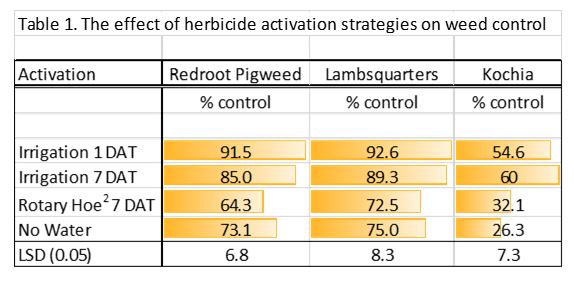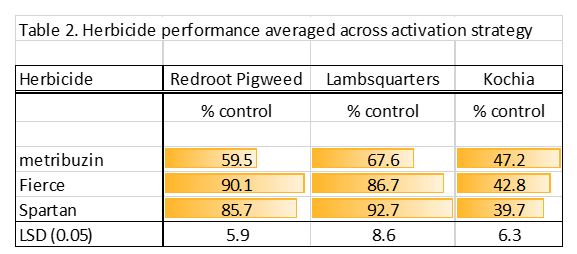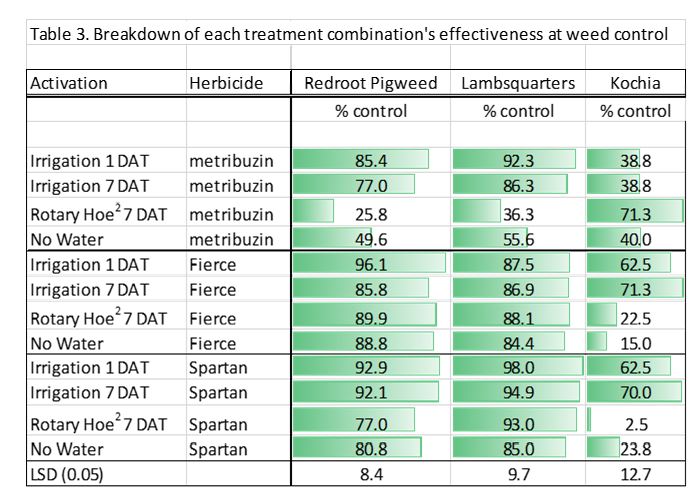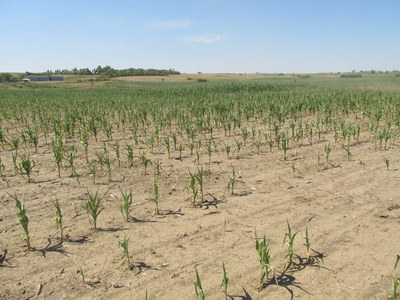Soybean PRE Herbicide Activation
A study was conducted over the 2016 and 2017 growing season to determine the consequences of delayed herbicide activation in soybeans. The study was conducted under a center pivot irrigation system to supply 0.5” of water to some of the treatments. The study consisted of three environments; a conventional and no-till site in 2016 and a conventional till site in 2017. The weeds present were redroot pigweed, common lambsquarters and kochia (2017 only). The herbicide treatments were metribuzin, Fierce, and Spartan, representing some of the most commonly used active ingredients in soybeans. Activation strategies included watering within 24 hours of herbicide treatment, watering 7 days after herbicide treatment, not watering at all, or using a rotary hoe to mechanically activate the products 7 days after application. In both years, there was sufficient delay in natural rainfall to evaluate treatment differences. In 2016 there was a 16 day delay in activating rain (1.49”) and 22 day delay in 2017 (0.79”). In both seasons, there were small intermittent rainfall events prior to the activation rainfall.
A common understanding about PRE activation is that smaller rainfall events totaling ~0.25” or more are not sufficient to activate a herbicide. This study provides further evidence that this is the case. In 2017, there was a rain event 6 and 7 days after herbicide application that totaled 0.19” in that 48 hour period, to go along with 0.09” total the following 7 days, yet herbicide performance was less in 2017 in treatments without irrigation water. Even though the total was 0.28”, the products were not activated until the 0.79” rainfall 22 DAT.
There was no decrease in herbicide efficacy with a 7 day delay in activation (Table 1). When averaged across herbicides, there was also no difference between mechanical incorporation and no activation strategy, except that mechanical incorporation decreased redroot pigweed control.

Fierce and Spartan were the most resilient products (Table 2). Metribuzin activity varied greatly with activation strategy which resulted in overall less weed control, however, metribuzin did out-perform Spartan across activation strategies. Fierce and Spartan performed similar to each other in this comparison.

When comparing all treatment combinations there are a few contrasts that stand out. For redroot pigweed and lambsquarters, Fierce was the most consistent performer (Table 3), with little or no decline in activity. Fierce activity to kochia did decline sharply when activation was absent or done mechanically. Spartan activity also sharply declined under the same circumstances. Metribuzin was an anomaly with kochia though I think there may be an explanation. Rotary hoeing was normally a bad decision with metribuzin (see redroot pigweed and lambsquarters), but control of kochia increases with mechanical incorporation. With only a single environment with kochia, the circumstances may have been unique. As noted above, there was a total of 0.19” or rainfall between 6 and 7 days after application. Mechanical incorporation occurred 7 DAT. I believe that was enough moisture to cause kochia germination (but not the other species) so the physical disturbance terminated the kochia rather than the herbicide. For the other species, the drop in control with mechanical incorporation may be due to planting weeds seeds while also not activating the product. Overall, metribuzin performance decreased the quickest with delayed activation. Data from this trial suggests a need to revisit any recommendation relating to mechanical incorporation of herbicides, with special attention to specific weed species and soil moisture status/precipitation.

Authors
Mike Ostlie, Ph.D., 701-652-2951, Research Agronomist / Assistant Director / Carrington Research Extension Center
Greg Endres, 701-652-2951, Cropping System Specialist/ Carrington Research Extension Center



